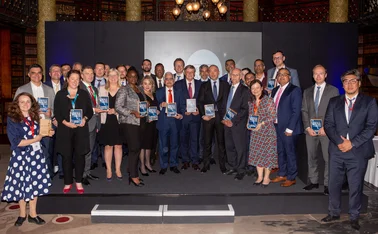
Digital transformation award: SSM digitalisation blueprint
ECB supervision arm has deployed an innovation hub to tackle an array of technological challenges

Central banks are embracing digitalisation. The range and quality of submissions to Central Banking’s inaugural award for digital transformation demonstrated the huge efforts that are afoot all around the world. Despite a reputation for conservatism, central banks are taking bold steps to review their internal processes and find ways of deploying technology to work in a more efficient, agile and impactful way.
In this fiercely competitive field, the European Central Bank’s efforts to digitise its supervisory arm stood out for the scale of its ambition and the broad scope of tools and governance structures under development. Not only is the Single Supervisory Mechanism reshaping its own work, but it is also rolling out innovations across the Eurosystem and supporting efforts outside the boundaries of the eurozone.

The ECB’s supervisory board launched the ‘SSM digitalisation blueprint’ in 2020, setting five areas of focus for the project. The blueprint would build innovative tools and systems; develop a common IT landscape; foster ‘digital culture’; run an advanced ‘innovation model’ at the SSM; and support innovation in the wider ‘ecosystem’ of academia, the private sector and other authorities.
“There was a top-down decision that this was an area where the ECB wants to invest, wants to be a leading institution in the use of new technologies,” says Elizabeth McCaul, ECB representative to the Supervisory Board. “It was a strategic decision, made first because supervisory technologies, or suptech as we call them, are becoming more prominent, but also because we have to deal with a very high number of tasks, data and processes.”
The SSM created a dedicated team and a steering committee. The ECB adopted a hub-and-spoke model with an innovation hub at the centre and different business areas forming the spokes. Teams across the Eurosystem could then propose ideas for processes to be digitised. The aim was to quickly build up a portfolio of use cases where digital tools could be deployed for maximum effect. By having supervisors come to the innovators with problems, tools could be designed to address what was needed on the frontlines.

Since then, the suptech hub has developed and rolled out 14 tools to support supervisors in their work across the SSM and also to central bankers in the European System of Central Banks as the tools are scalable beyond banking supervision. Some are expansive, such as a ‘virtual lab’ that allows digital collaboration, code-sharing and cloud computing across the SSM and ESCB. Around 10,000 SSM supervisors and ESCB central bankers are registered on the platform and more than 3,000 use it regularly. Other tools are tailored to specific needs, such as Medusa, an artificial intelligence application that applies consistency checks to banks’ internal model assessment reports. Another tool, named after Heimdall, the watchman of the Norse gods, automates large parts of the assessment of bank executives. Daniela Schackis, deputy director-general for SSM governance and operations, notes each assessment is a “very complicated process”, requiring sensitive handling of several files and personal data, which was challenging to automate. Medusa and Heimdall are each expected to benefit a few hundred specialised experts.
One of the most ambitious elements of the SSM blueprint is Athena, an AI-driven textual analysis platform that provides thousands of supervisors with natural-language processing tools. Athena allows central bankers to review vast amounts of unstructured data to highlight key supervisory risks. The platform can handle documents in multiple languages and formats, and provides automatic risk classification, rapid search functions and translation of documents into English. Dashboards allow users to compare findings across institutions. Athena also offers sentiment analysis of financial news stories as another means of identifying risks.
Observers from outside the eurozone point to Athena as a particularly impressive piece of technology. One official from a major central bank says: “With Athena, the ECB team has really harnessed the power of data for enabling better decision-making. The dashboarding work brings more clarity but also speed and optimisation. That is definitely something we have learned from.”
A major challenge encountered by all central banks trying to digitise their operations is the need to train staff and help them shift their mindsets away from the old way of working. One of the goals of the blueprint was to find a more agile way of working. The suptech hub develops and tests ideas jointly with end-users and IT experts, and drops the ones that don’t work. The blueprint also required the ECB to strengthen its innovation ecosystem, which also helped in establishing key partnerships with highly specialised start-ups. They have contributed with tailor-made technologies and solutions, for instance bringing their expertise with certain AI applications.

“Cultural transformation is an ongoing effort that is as important as adopting new technologies and developing cutting-edge tools,” says McCaul. “Some teams have enthusiastically adopted the new tools, while others performing similar duties have held back.”
To foster an innovative mindset and ensure adoption of new tools, the ECB has trained around 3,000 supervisors across the SSM in data science in partnership with Coursera, an online training platform.
It also brings together supervisors, corporations and academia from around the world for the Supervision Innovators Conference, an annual event to connect on supervisory technologies, share experiences and display innovative tools – more than 1,000 participants attended the 2023 edition.
Rafael Garcia Oliva, deputy director-general for information systems, says the blueprint was designed to be a three-year plan, running until the end of 2023. Supervisory Board members from the ECB and the national competent authorities have since decided to continue the work further and develop an even more holistic SSM tech strategy for the coming years. “We see a growing business demand for emerging technologies and for continuous innovation. Embedding AI capabilities effectively into our business processes and systems will be crucial for our success,” Garcia Oliva says. “We anticipate more IT-driven innovations for all our business functions in the future.”
The Central Banking Awards 2024 were written by Christopher Jeffery, Daniel Hinge, Dan Hardie, Joasia Popowicz, Ben Margulies, Riley Steward, Jimmy Choi and Blake Evans-Pritchard.
Only users who have a paid subscription or are part of a corporate subscription are able to print or copy content.
To access these options, along with all other subscription benefits, please contact info@centralbanking.com or view our subscription options here: http://subscriptions.centralbanking.com/subscribe
You are currently unable to print this content. Please contact info@centralbanking.com to find out more.
You are currently unable to copy this content. Please contact info@centralbanking.com to find out more.
Copyright Infopro Digital Limited. All rights reserved.
You may share this content using our article tools. Printing this content is for the sole use of the Authorised User (named subscriber), as outlined in our terms and conditions - https://www.infopro-insight.com/terms-conditions/insight-subscriptions/
If you would like to purchase additional rights please email info@centralbanking.com
Copyright Infopro Digital Limited. All rights reserved.
You may share this content using our article tools. Copying this content is for the sole use of the Authorised User (named subscriber), as outlined in our terms and conditions - https://www.infopro-insight.com/terms-conditions/insight-subscriptions/
If you would like to purchase additional rights please email info@centralbanking.com
Most read
- ECB says iPhone is currently incompatible with digital euro
- Supervisors grapple with the smaller bank dilemma
- ‘Do I die, or do I survive?’ Officials reflect on Basel III complexity






